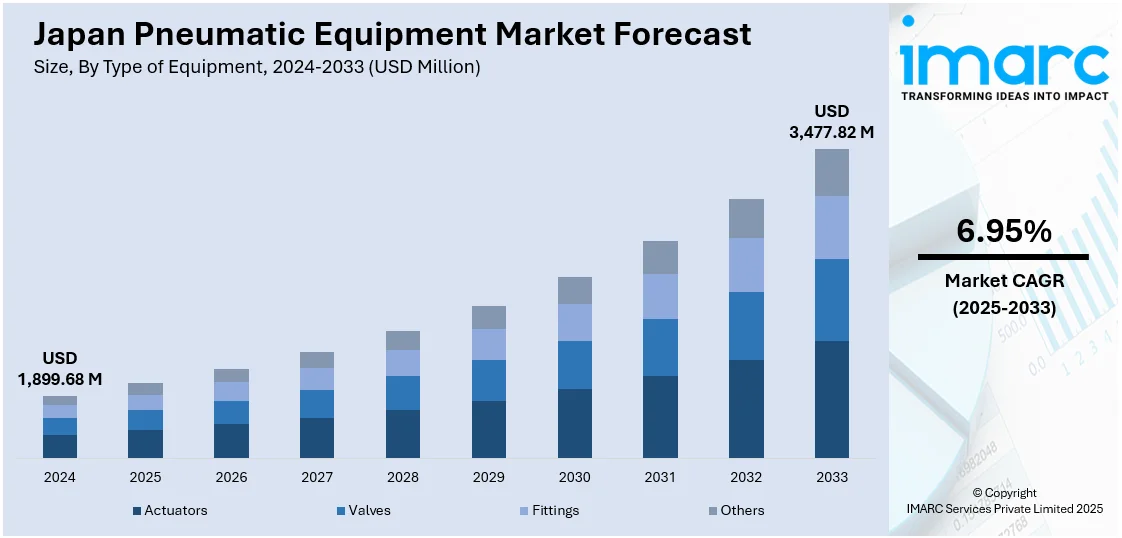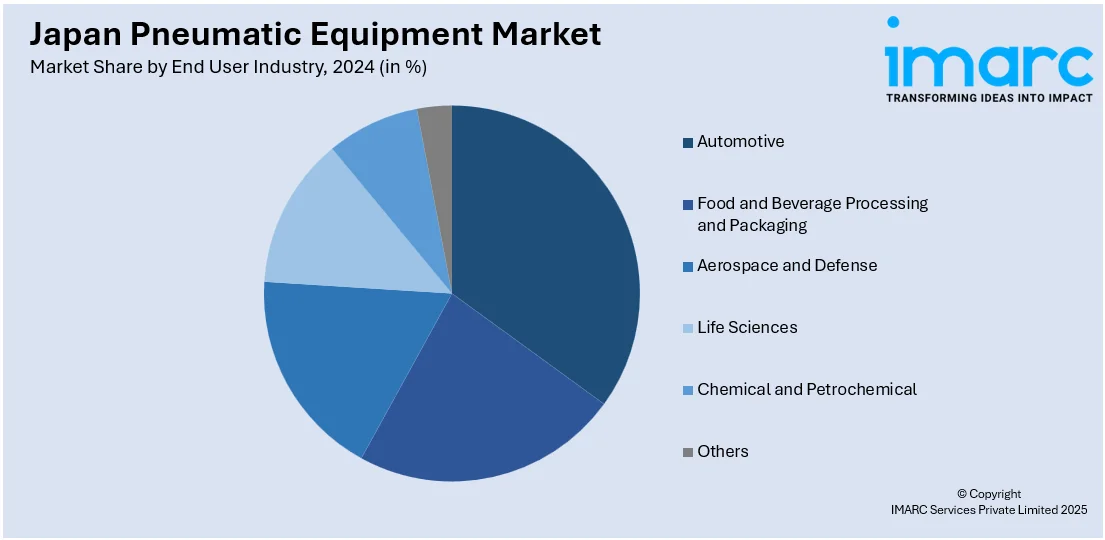
Japan Pneumatic Equipment Market Size, Share, Trends and Forecast by Type of Equipment, End User Industry, and Region, 2025-2033
Japan Pneumatic Equipment Market Overview:
The Japan pneumatic equipment market size reached USD 1,899.68 Million in 2024. Looking forward, IMARC Group expects the market to reach USD 3,477.82 Million by 2033, exhibiting a growth rate (CAGR) of 6.95% during 2025-2033. The market is witnessing steady growth driven by increased automation in manufacturing, adoption of predictive maintenance tools, and rising demand for energy-efficient systems. These factors are encouraging industrial upgrades and expanding the Japan pneumatic equipment market share across multiple application sectors.
|
Report Attribute
|
Key Statistics
|
|---|---|
|
Base Year
|
2024 |
|
Forecast Years
|
2025-2033
|
|
Historical Years
|
2019-2024
|
| Market Size in 2024 | USD 1,899.68 Million |
| Market Forecast in 2033 | USD 3,477.82 Million |
| Market Growth Rate 2025-2033 | 6.95% |
Japan Pneumatic Equipment Market Trends:
Rising Adoption of Smart and Predictive Maintenance Solutions
The demand for intelligent maintenance technologies is shaping the direction of Japan’s pneumatic equipment market. Industries are shifting toward predictive diagnostics and automated upkeep to reduce unplanned downtime and optimize efficiency. This trend is gaining traction as factories look for solutions that extend equipment lifespan while lowering operational costs. Air compressors, a core component of pneumatic systems, are particularly affected by this shift, as they often require scheduled monitoring to prevent failure. Companies are now focusing on minimizing manual inspections by introducing data-driven solutions capable of predicting faults before they occur. In June 2024, Hitachi Industrial Equipment Systems launched a predictive diagnosis service for its NEXT3 series air compressors, integrating remote monitoring with machine learning and expert technician knowledge. The system analyzes sensor data to detect temperature-related issues, which were found to be the cause of nearly 75% of compressor failures. This allowed for earlier intervention, improved operational uptime, and reduced energy consumption. The introduction of such services is transforming how industrial sites manage their pneumatic systems, offering more proactive and precise approaches to maintenance. As more companies adopt predictive tools, the trend toward intelligent diagnostics is expected to continue driving growth in Japan’s pneumatic equipment industry.

Growth in Automation-Driven Equipment Deployment
Automation is increasingly becoming a core requirement in Japan’s industrial sector, directly driving the need for high-precision pneumatic equipment. As companies seek to streamline manufacturing, automated material handling and integrated digital systems are becoming essential. Pneumatic systems, with their reliable actuation and control features, are widely adopted in such environments. These systems power conveyor movements, robotic gripping, and pressure-based control tasks in manufacturing lines that demand speed, accuracy, and minimal human intervention. In September 2024, DENSO announced the establishment of a next-generation unmanned plant at its Zenmyo facility in Aichi. Designed for 24-hour operation, the plant will use digital twin simulations, automated internal logistics, and a sensor-integrated control environment to optimize production. Pneumatic components play a major role in handling repetitive material transfers and maintaining pressure consistency throughout the automated setup. By building a fully digital and sensor-led production ecosystem, DENSO highlighted the role of pneumatic systems in achieving seamless coordination between machines. The push for uncrewed operations to address Japan’s labor shortage has made such automation necessary. As more facilities follow this model, the market is seeing increased investment in durable, low-maintenance pneumatic components tailored for intelligent factory systems. This rising automation demand is a key factor driving Japan's pneumatic equipment market growth, shaping the future of the country’s industrial equipment landscape.
Japan Pneumatic Equipment Market Segmentation:
IMARC Group provides an analysis of the key trends in each segment of the market, along with forecasts at the country and regional level for 2025-2033. Our report has categorized the market based on type of equipment and end user industry.
Type of Equipment Insights:
- Actuators
- Valves
- Fittings
- Others
The report has provided a detailed breakup and analysis of the market based on the type of equipment. This includes actuators, valves, fittings, and others.
End User Industry Insights:

- Automotive
- Food and Beverage Processing and Packaging
- Aerospace and Defense
- Life Sciences
- Chemical and Petrochemical
- Others
A detailed breakup and analysis of the market based on the end user industry have also been provided in the report. This includes automotive, food and beverage processing and packaging, aerospace and defense, life sciences, chemical and petrochemical, and others.
Regional Insights:
- Kanto Region
- Kansai/Kinki Region
- Central/ Chubu Region
- Kyushu-Okinawa Region
- Tohoku Region
- Chugoku Region
- Hokkaido Region
- Shikoku Region
The report has also provided a comprehensive analysis of all the major regional markets, which include Kanto Region, Kansai/Kinki Region, Central/ Chubu Region, Kyushu-Okinawa Region, Tohoku Region, Chugoku Region, Hokkaido Region, and Shikoku Region.
Competitive Landscape:
The market research report has also provided a comprehensive analysis of the competitive landscape. Competitive analysis such as market structure, key player positioning, top winning strategies, competitive dashboard, and company evaluation quadrant has been covered in the report. Also, detailed profiles of all major companies have been provided.
Japan Pneumatic Equipment Market News:
- March 2025: Mitsubishi Heavy Industries Thermal Systems launched 31 residential air-conditioner models in Japan featuring AI-based airflow control, motion and thermal sensors, and smart automation. This advanced integration of sensor-driven pneumatic components enhanced energy efficiency and boosted demand in Japan’s pneumatic equipment market.
- June 2024: Hitachi Industrial Equipment Systems launched a predictive diagnosis service for NEXT3 series air compressors using machine learning and technician insights. This advancement improved maintenance efficiency, reduced downtime, and supported energy-saving operations, contributing significantly to the growth of Japan’s pneumatic equipment market.
Japan Pneumatic Equipment Market Report Coverage:
| Report Features | Details |
|---|---|
| Base Year of the Analysis | 2024 |
| Historical Period | 2019-2024 |
| Forecast Period | 2025-2033 |
| Units | Million USD |
| Scope of the Report |
Exploration of Historical Trends and Market Outlook, Industry Catalysts and Challenges, Segment-Wise Historical and Future Market Assessment:
|
| Types of Equipment Covered | Actuators, Valves, Fittings, Others |
| End User Industries Covered | Automotive, Food and Beverage Processing and Packaging, Aerospace and Defense, Life Sciences, Chemical and Petrochemical, Others |
| Regions Covered | Kanto Region, Kansai/Kinki Region, Central/ Chubu Region, Kyushu-Okinawa Region, Tohoku Region, Chugoku Region, Hokkaido Region, Shikoku Region |
| Customization Scope | 10% Free Customization |
| Post-Sale Analyst Support | 10-12 Weeks |
| Delivery Format | PDF and Excel through Email (We can also provide the editable version of the report in PPT/Word format on special request) |
Key Questions Answered in This Report:
- How has the Japan pneumatic equipment market performed so far and how will it perform in the coming years?
- What is the breakup of the Japan pneumatic equipment market on the basis of type of equipment?
- What is the breakup of the Japan pneumatic equipment market on the basis of end user industry?
- What is the breakup of the Japan pneumatic equipment market on the basis of region?
- What are the various stages in the value chain of the Japan pneumatic equipment market?
- What are the key driving factors and challenges in the Japan pneumatic equipment market?
- What is the structure of the Japan pneumatic equipment market and who are the key players?
- What is the degree of competition in the Japan pneumatic equipment market?
Key Benefits for Stakeholders:
- IMARC’s industry report offers a comprehensive quantitative analysis of various market segments, historical and current market trends, market forecasts, and dynamics of the Japan pneumatic equipment market from 2019-2033.
- The research report provides the latest information on the market drivers, challenges, and opportunities in the Japan pneumatic equipment market.
- Porter's five forces analysis assist stakeholders in assessing the impact of new entrants, competitive rivalry, supplier power, buyer power, and the threat of substitution. It helps stakeholders to analyze the level of competition within the Japan pneumatic equipment industry and its attractiveness.
- Competitive landscape allows stakeholders to understand their competitive environment and provides an insight into the current positions of key players in the market.
Need more help?
- Speak to our experienced analysts for insights on the current market scenarios.
- Include additional segments and countries to customize the report as per your requirement.
- Gain an unparalleled competitive advantage in your domain by understanding how to utilize the report and positively impacting your operations and revenue.
- For further assistance, please connect with our analysts.
 Request Customization
Request Customization
 Speak to an Analyst
Speak to an Analyst
 Request Brochure
Request Brochure
 Inquire Before Buying
Inquire Before Buying




.webp)




.webp)












